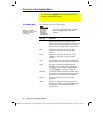
64 Chapter 3: Symbolic Manipulation
03SYMBOL.DOC TI-89/TI-92 Plus: Symbolic Manipulation (English) Susan Gullord Revised: 02/23/01 10:52 AM Printed: 02/23/01 2:12 PM Page 64 of 24
All of the following rules are applied automatically. You do not see
intermediate results.
¦ If a variable has a defined value, that value replaces the variable.
If the variable is defined in terms
of another variable, the variable
is replaced with its “lowest level”
value (called infinite lookup).
Default simplification does not modify variables that use path
names to indicate a folder. For example,
x+class\x
does not
simplify to
2x
.
¦ For functions:
− The arguments are simplified. (Some built-in functions delay
simplification of some of their arguments.)
− If the function is a built-in or user-defined function, the
function definition is applied to the simplified arguments.
Then the functional form is replaced with this result.
¦ Numeric subexpressions are
combined.
¦ Products and sums are sorted
into order.
Products and sums involving undefined variables are sorted
according to the first letter of the variable name.
− Undefined variables
r
through
z
are assumed to be true
variables, and are placed in alphabetical order at the
beginning of a sum.
− Undefined variables
a
through
q
are assumed to represent
constants, and are placed in alphabetical order at the end of a
sum (but before numbers).
¦ Similar factors and similar terms
are collected.
Automatic Simplification
When you type an expression on the entry line and press
¸
, the
TI
-
89 / TI
-
92 Plus automatically simplifies the
expression according to its default simplification rules.
Default
Simplification Rules
Note: For information about
folders, refer to Chapter 5.
Note: Refer to “Delayed
Simplification for Certain
Built-In Functions” on
page 66.


















